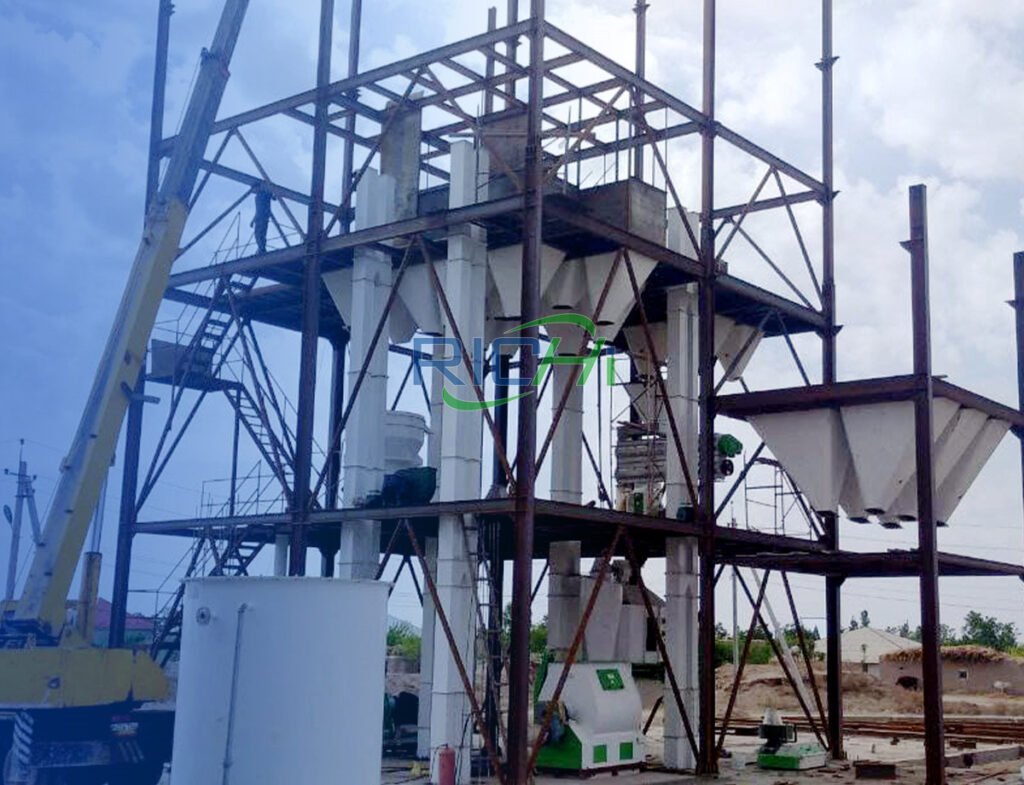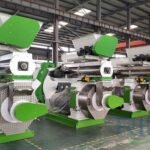The rising demand for high-quality animal feed is driven by the expanding livestock industry. A 10t/h animal feed manufacturing machine is engineered to efficiently produce a large volume of feed pellets, ensuring livestock receive the necessary nutrition for optimal growth and productivity. Understanding the production process of this machine is vital for operators and managers to maintain smooth operations and achieve high-quality output. This article outlines the key steps involved in the production process of a 10t/h animal feed manufacturing machine.
1. Raw Material Preparation
The first step in the production process is preparing the raw materials. The quality and composition of these materials directly affect the nutritional value and quality of the final feed pellets.
- Selection of Raw Materials: Common raw materials for animal feed include grains (such as corn, wheat, and barley), protein sources (like soybean meal and fish meal), vitamins, minerals, and other additives. The selection should align with the nutritional requirements of the target livestock.
- Grinding: The raw materials are typically ground into smaller particles to enhance the efficiency of the pelleting process. A hammer mill is often employed for this purpose. Grinding ensures a uniform particle size, which is crucial for achieving consistent pellet quality.
- Mixing: After grinding, the raw materials are thoroughly mixed to ensure even nutrient distribution. A feed mixer combines the ground materials with additives, vitamins, and minerals. Proper mixing is essential for producing high-quality feed pellets that meet nutritional standards.

2. Conditioning
Conditioning is a vital step that adds moisture and heat to the mixed raw materials before they enter the pellet mill.
- Purpose of Conditioning: The main goal of conditioning is to soften the raw materials, allowing for better compression during pelleting. It also activates the natural binding agents in the materials, enhancing pellet durability.
- Process: Steam or hot water is typically added to the mixture in the conditioner. The temperature and moisture content are carefully controlled to achieve optimal conditions. Conditioning generally occurs just before the material enters the pellet mill.
3. Pelleting
The pelleting process transforms the conditioned raw materials into pellets.
- Pellet Mill Operation: The conditioned mixture is fed into the pellet mill, where it is compressed through a die using rollers. The pressure and heat generated during this process bind the materials together, forming pellets.
- Die Selection: The choice of die size and type impacts the diameter and quality of the produced pellets. Pellet sizes commonly range from 2mm to 8mm, depending on the target livestock species.
- Cooling: After exiting the pellet mill, the pellets are hot and soft, requiring cooling to harden and stabilize. A counter-flow cooler is often used to reduce the temperature of the pellets, ensuring they maintain their shape and quality during storage and transportation.
4. Screening
Screening is a crucial step that ensures the uniformity and quality of the final product.
- Purpose of Screening: The primary aim of screening is to separate any fines (small particles) from the finished pellets. Fines can adversely affect the quality and marketability of the feed.
- Process: A vibrating screen or rotary screener removes fines from the pellets. The screened pellets are collected for packaging, while the fines can be recycled back into the production process or utilized for other purposes.
5. Packaging
Once the pellets have been cooled and screened, they are ready for packaging.
- Packaging Options: The finished feed pellets can be packaged in various ways, such as bulk bags, smaller bags (e.g., 25kg or 50kg), or bulk containers for large-scale distribution. The choice of packaging depends on the target market and customer preferences.
- Automation: Many modern animal feed manufacturing plants use automated packaging systems to improve efficiency and reduce labor costs. These systems can quickly and accurately weigh, fill, and seal bags.
6. Quality Control
Quality control is an ongoing process throughout the production cycle to ensure the final product meets required standards.
- Testing: Samples of the finished pellets should be tested for nutritional content, moisture levels, and physical characteristics (such as hardness and durability). Regular testing helps identify deviations from quality standards and facilitates corrective actions.
- Record Keeping: Maintaining detailed records of raw material sources, production parameters, and quality control results is essential for traceability and compliance with industry regulations. (Related post:small feed making machine)
7. Maintenance and Upkeep
To ensure the continuous operation of the 10t/h animal feed manufacturing machine, regular maintenance and upkeep are essential.
- Routine Inspections: Operators should conduct regular inspections of the machine to identify any signs of wear or damage. Key components, such as the die, rollers, and bearings, should be checked routinely.
- Preventive Maintenance: Establishing a preventive maintenance schedule minimizes downtime and extends the equipment’s lifespan. This may include lubrication, part replacements, and cleaning.
Conclusion
The production process of a 10t/h animal feed manufacturing machine involves several critical steps, including raw material preparation, conditioning, pelleting, screening, packaging, quality control, and maintenance. Understanding each stage of the process is vital for operators and managers to ensure efficient operations and high-quality output.
By implementing best practices at each stage of production, businesses can enhance productivity, reduce costs, and meet the growing demand for high-quality animal feed. As the livestock industry continues to expand, investing in efficient animal feed manufacturing processes will be crucial for success in this competitive market.


